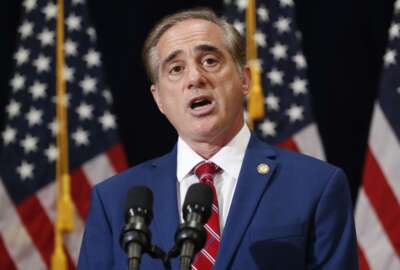

The Veterans Affairs Department has a shortage of medical professionals, but it also lacks the human resources expertise and flexibility it needs to bring top t...
When the health care industry sneezes, the Veterans Affairs Department has been to known to catch a cold.
The sentiment is true today, as the Health and Resources Services Administration predicts the national demand for physicians will exceed the supply by 2025. At VA, 138 out of 140 medical centers cited staffing shortages for medical professionals, according to a recent assessment from the agency’s inspector general.
The department isn’t entirely sure exactly how many vacancies it has, because VA’s human resources system doesn’t track or include data on all positions, the Government Accountability Office recently told the House Veterans Affairs Committee. The department itself estimates it has anywhere between 35,000-to-40,000 vacancies.
But when it comes to the department’s struggles to recruit and retain top medical professionals, VA has symptoms of a more serious, deeply-rooted illness.
The department can’t hire and develop strategic plans to recruit and retain top medical talent quickly enough, because more than 90 VA medical centers cited shortages with one position in particular: human resources specialists.
Federal agencies broadly have a shortage of human resources talent, but the gap — again — is especially glaring at VA. The agency has several hundred vacancies for human resources specialists, and the HR experts VA does have must juggle and navigate the arcane rules of three separate personnel systems. The agency has 19 people who recruit for physicians to work at one of 1,252 VA facilities across the country.
Peter Shelby, VA’s assistant secretary for human resources and administration, said the department has made some progress. VA filled more than 16,000 vacancies since March 2018 and increased its end strength by 3,000. As of April, it’s hired 422 HR specialists.
For an organization of nearly 385,000 employees, VA’s vacancy rates aren’t as dire as they may seem, Shelby said.
“Taken in context, VA’s vacancy and turnover rates are very low,” he told the committee at a June 21 hearing. “We fluctuate between 9-and-10 percent, which compares very favorably with the private sector.”
Others, however, have a different view of VA’s retention challenges.
Roughly 32 percent of employees with less than two years of service quit their position at the Veterans Health Administration between 2011 and 2017, Max Stier, president and CEO of the Partnership for Public Service, said, citing data from the from the Office of Personnel Management.
More VHA employees left their positions in 2016 compared to the previous five years, GAO said, citing voluntary resignations and retirements as the main reason for their departures.
Shelby said he’s especially focused on vacancies in specific, specialty-care occupations rather than the total number.
“What’s critically important to focus on is our critical shortfalls,” he said. “Overall vacancy rate doesn’t tell me where we’re not meeting the needs of veterans. Focusing on critical shortfalls does.”
The department has stood up a specialty care working group, which is developing staffing models for these occupations, Shelby said. The working group is expected to finish those staffing plans by December.
Both VA and members on the House committee agreed: successful recruitment and retention happens when the agency has top leadership involved in leading the organization’s local HR strategy.
“The supervisors and managers have to get involved in talent management,” Shelby said. “They own their organizations. HR is a consultant to make sure we hire legally. They’re the experts that run their organizations and understand the talent they need, so they have to be more involved. We’re working toward that model, where HR is a consultant and a business partner and we have operations supporting every effort to find talent to bring into those organizations.”
Interest should start at the top with the medical center director. VA currently has vacancies for 20 medical center director positions.
Congress gave the department direct-hire authority for medical center directors when it passed the VA Choice and Quality Employment Act last summer.
But the direct-hire authority isn’t much help, when salaries for medical center directors are still capped at $153,000 a year, often lower than what the senior executives in their own organizations make.
“It’s an extremely demanding job,” Shelby said of the medical center director job. “The counterparts in the private sector in some cases make four or five times what we’re capable of making in certain markets. [If] you combine that with the workload, it’s very difficult to retain them. In recruiting them … we got direct hire authority, we moved to use that, and we’re capped on salary at $153,000 a year. We tried direct hire authority on two medical centers. We went through the entire process, made the offer and they rejected the offer just because we could not meet their salary demands.”
Shelby estimated VA would need to offer a maximum of $600,000 a year to lure talented professionals to lead the agency’s hospitals in certain markets.
“I want the flexibility within that market to compete with the local talent there, and I won’t have to pay as high,” he told the House Veterans Affairs Committee last month. “We have a compelling mission. The benefits packages that the federal government provides are better than most private sector benefits packages. That, combined with the mission of serving veterans, we can compete.”
VA is also seeking more flexibility in its personnel systems. The department currently has employees in three separate systems: Title 5, Title 38 and Title 38-Hybrid.
“Having three pay systems does not give us the agility that we need,” Shelby said. “As you saw in the IG report, it’s very unique and local, and having a market-based personnel system will give the agility we need in each market to the target the talent and compete with the local competition there.”
Copyright © 2024 Federal News Network. All rights reserved. This website is not intended for users located within the European Economic Area.
Nicole Ogrysko is a reporter for Federal News Network focusing on the federal workforce and federal pay and benefits.
Follow @nogryskoWFED


